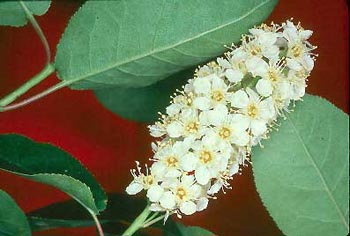Chokecherry

Common Name(s):
Chokecherry
Scientific Name:
Prunus virginiana L.
Scientific Name Synonyms:
None known
Symbol:
PRVI
Description:
Life Span: Perennial
Origin: Native
Season: Deciduous
Growth Characteristics: A shrub or small tree, growing erect, 6 to 25 feet tall, with horizontal branches, growing in dense thickets. Flowers April to July, fruits mature July to September. It reproduces from seeds, rhizomes, and basal sprouts.
Flowers/Inflorescence: Flowers are white and in long, dense clusters. The fragrant flowers have 5 sepals, 5 petals, and many stamens.
Fruits/Seeds: Produces a dark red to black, fleshy, cherry-like fruit. The fruit is tart and astringent, being ¼ to ½ inch in diameter.
Leaves: Alternate and deciduous, oval to somewhat oblong, with serrated margins. Leaves are 1 to 3 ½ inches long. Underside of leaf is somewhat paler than top of leaf. There are 2 glands at the top of the petiole. Leaves turn bright yellow to orange in fall.
Stems: Twigs slender, reddish-brown to orangish-brown. The bark is gray to black, with prominent "corky" spots on the bark (lenticels), which are reddish-white. The trunk is dark red. The wood is hard, heavy, and light colored.
Ecological Adaptions:
Chokecherry is common in the foothills and mountain canyons, along streambanks or in moist places, at elevations of 4,900 to 10,200 feet.
Soils: Most abundant on moist soils, but adapted to a broad range of soil types.
Associated Species: Willow, aspen, alder, ponderosa pine, mountain brome, snowberry.
Uses and Management:
Chokecherry is widely regarded as an important wildlife food plant and provides habitat, watershed protection, and species diversity. Fruits, leaves, and twigs are utilized. Large mammals including bears, moose, coyotes, bighorn sheep, pronghorn, elk, and deer use chokecherry as browse. Chokecherry is also a food source for small mammals. The fruits are an important food for many birds. Cattle and domestic sheep also eat chokecherry, and because of its toxicity (see below), poisoning sometimes occurs. Livestock normally do not eat fatal quantities except when other forage is scarce.
Poisoning is caused by toxic quantities of hydrocyanic acid in leaves, stems, and seeds. It is believed to be poisonous to all classes of livestock, and poisoning generally occurs when the plant is stressed from drought or freezing. For poisoning to be fatal, an animal must eat a toxic dose (0.25% of its bodyweight) in 30 minutes to 1 hour. Signs of poisoning include distress, blue coloring of the mouth, rapid breathing, salivation, muscle twitching, coma, and death.
The fruits of chokecherry are used to make wines, syrups, jellies, and jams. The bark is sometimes used as a flavoring agent in cough syrup. American Indians used bark extract to cure diarrhea. The fruits were used to treat canker sores, cold sores, and added to pemmican. The Paiutes made a medicinal tea from the leaves and twigs to treat colds and rheumatism. The wood was used for arrows, bows, and pipe stems.

